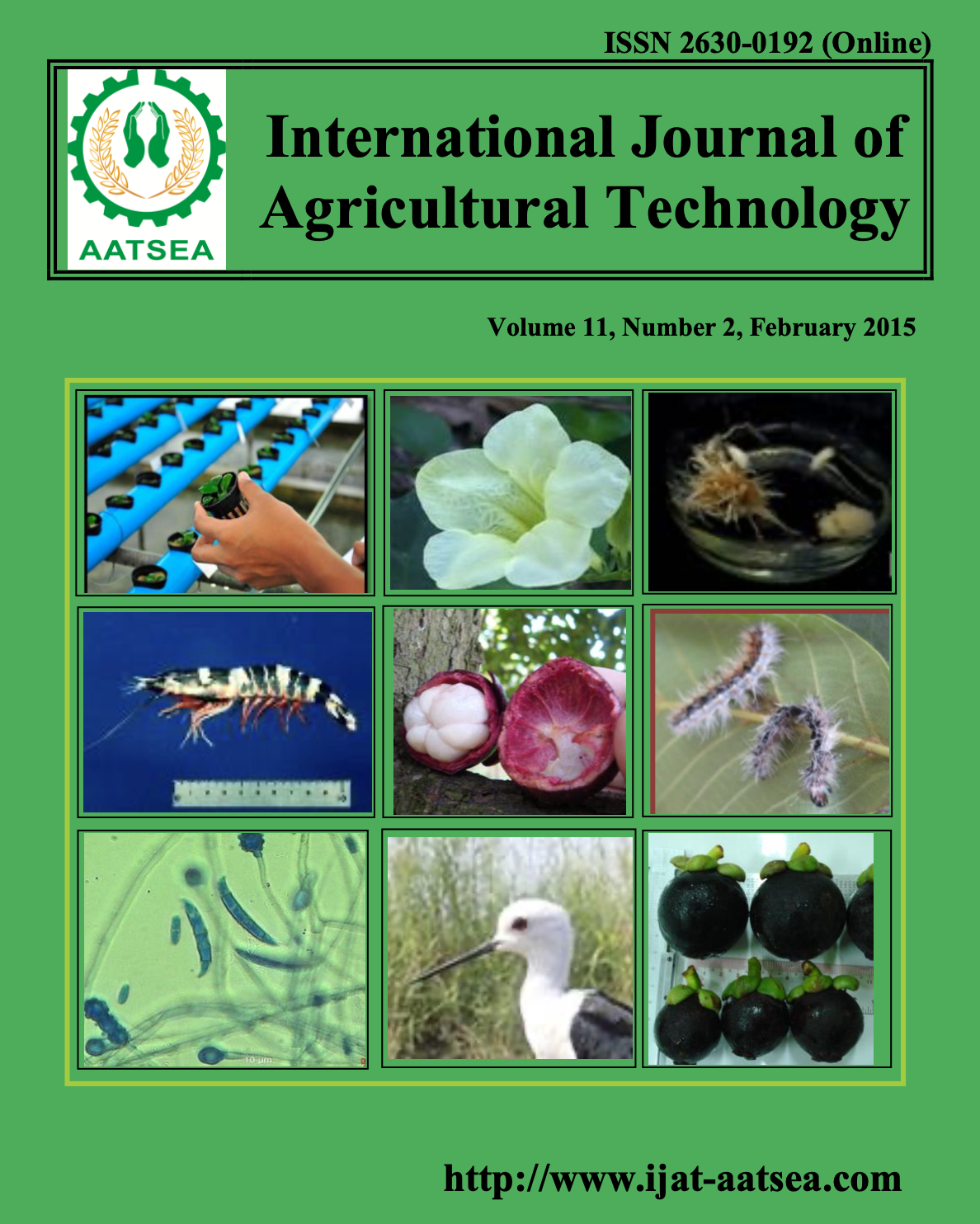Evidence of molecular marker for genetic relationship of Asystasia gangetia (Linn) T. Anderson
Main Article Content
Abstract
(L.) T. Anderson (Acanthaceae) is widespread throughout the old world tropics. The plant is cultivated as an ornamental and various parts of the plant are also used traditionally for many ailments and diseases. Two subspecies are recognized in Thailand (1) A. gangetica micrantha that flowers are mostly white with two parallel purple blotches lines on the bottom petal lobe and (2) A. gangetica gangetica that flowers are various shades color as a pink, mauve or purplish with paler throats and white or cream with pale yellowish throats. However, there are comparatively a lesser number of reports focusing on intraspecific genetic diversity studies. The genetic diversity of a local subpopulation of A. gangetica was surveyed using random amplified polymorphic DNA (RAPD) analysis. A total of sixty-four random primers were used and eight primers (OPA-01, OPA-12, OPA-16, OPA-18, OPA-20, OPC02, OPC-05 and OPH-05) were produced reproducible fragments with easily recordable bands which were selected for analysis. A total of 91 bands were detected with an average of 11.4 bands per primer. The genetic similarities were estimated from banding pattern using UPGMA clustering method. The Pearson’s similarity coefficients were used to construct a UPGMA dendrogram. Pair-wise estimates of genetic similarity ranged from 0.17 to 1.00. Five primary genotypes were found within a sampling of 30 individuals: white flowers with purple markings on the bottom petal lobe (A. gangetica micrantha), purple, white, pink and yellow flowers. Our result showed the RAPD marker for assessing genetic relationship among A. gangetica that correspond to flower color.
Article Details

This work is licensed under a Creative Commons Attribution-NonCommercial-NoDerivatives 4.0 International License.
References
Akah, P. A., Ezike, A. C., Nwafor, S. V., Okoli, C. O. and Enwerem, N. M. (2003). Evaluation of the anti-asthmatic property of Asystasia gangetica leaf extracts. Journal of Ethnopharmacology 89:25-36.
Doyle, J. J. and Doyle, J. L. (1987). A rapid DNA isolation procedure for small quantities of fresh leaf tissue. Phytochemical Bulletin 19:11-15.
Fong, S. Y., Piva, T., Urban, S. and Huynh, T. (2014). Genetic homogeneity of vegetatively propagated Clinacanthus nutans (Acanthaceae). Journal of Medicinal Plants Research 8:903-914.
Hamid, A. A., Aiyelaagbe, O. O., Ahmed, R. N., Usman, L. A. and Adebayo, S. A. (2011). Preliminary Phytochemistry, Antibacterial and Antifungal Properties of extracts of Asystasia gangetica Linn T. Anderson grown in Nigeria. Advances in Applied Science Research 2:219-226.
Kanchanapoom, T. and Ruchirwat, S. (2007). Megastigmane glucoside from Asystasia gangetica (L.). Journal of Natural Medicines 61:430-433.
Kumar, S. L. (1999). DNA markers in plant improvement: An overview. Biotechnology Advance 17:43-182.
Mabberley, D. J. (1987). The Plant Book. Cambridge: Cambridge University Press.
Mcdade, L. A. and Moody, M. L. (1999). Phylogenetic relationshipsamong Acanthaceae: evidence from non-coding trnL-trnF chloroplast DNA sequences. American Journal of Botany 86:70-80.
Mepba, H. D., Eboh, L. and Banigo, D. E. B. (2007). Effects of processing treatments on the nutritive composition and consumer acceptance of some Nigerian edible leafy vegetables. African Journal of Food, Agriculture, Nutrition and Development 7:1-18.
Lattoo, S. K., Dhar, R. S., Khan, S., Bamotra, S., Bhan, M. K., Dhar, A. K. and Gupta, K. K. (2008). Comparative analysis of genetic diversity using molecular and morphometric markers in Andrographis paniculata (Burm. f.) Nees. Genetic Resources and Crop Evolution 55:33-43.
Pandit, M. K., Tan, H. T. W. and Bisht, M. S. (2006). Polyploidy in invasive plant species of Singapore. Botanical Journal of the Linnean Society 151:395-403.
Rohlf, F. J. (2000). NTSYS-pc. Numerical Taxonomy and Multivariate Analysis System. Version 2.1. New York. United States of America: Exeter Publications.
Sneath, P. H. A. and Sokal, R. R. (1973). Numerical taxonomy. San Francisco: W. H. Freeman.
Tilloo, S. K., Pande, V. B., Rasala, T. M. and Kale, V. V. (2012). Asystasia gangetica: Review on multipotential application. International Research Journal of Pharmacy 3:18-20.
Williams, J. G. K., Kubelik, A. R., Livak, K. J., Rafalski, J. A. and Tingey, S. V. (1990). DNA polymorphisms amplified by arbitrary primers are useful as genetic markers. Nucleic Acids Research 18:6531-6535.
Waugh, R. and Powell, W. (1992). Using RAPD markers for crop improvement. Trends Biotechnology 10:186-191.


